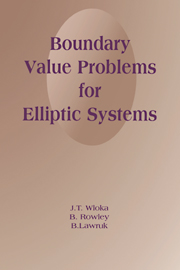Book contents
- Frontmatter
- Contents
- Preface
- Index of Notation
- PART I A Spectral Theory of Matrix Polynomials
- PART II Manifolds and Vector Bundles
- PART III Pseudo-Differential Operators and Elliptic Boundary Value Problems
- PART IV Reduction of a Boundary Value Problem to an Elliptic System on the Boundary
- PART V An Index Formula for Elliptic Boundary Problems in the Plane
- References
- Index
Preface
Published online by Cambridge University Press: 07 May 2010
- Frontmatter
- Contents
- Preface
- Index of Notation
- PART I A Spectral Theory of Matrix Polynomials
- PART II Manifolds and Vector Bundles
- PART III Pseudo-Differential Operators and Elliptic Boundary Value Problems
- PART IV Reduction of a Boundary Value Problem to an Elliptic System on the Boundary
- PART V An Index Formula for Elliptic Boundary Problems in the Plane
- References
- Index
Summary
This book examines the theory of boundary value problems for elliptic systems of partial differential equations, a theory which has many applications in mathematics and the physical sciences. The aim is to simplify and to algebraize the index theory by means of pseudo-differential operators and new methods in the spectral theory of matrix polynomials. This latter theory provides important tools that will enable the reader to work efficiently with the principal symbols of the elliptic and boundary operators. It also leads to important simplifications and unifications in the proofs of basic theorems such as the reformulation of the Lopatinskii condition in various equivalent forms, homotopy lifting theorems, the reduction of a system with boundary conditions to a system on the boundary, and the index formula for systems in the plane.
The book is suitable for use in graduate level courses on partial differential equations, elliptic systems, pseudo-differential operators, and matrix algebra. All the theorems are proved in detail, and the methods are well illustrated through numerous examples and exercises.
There are five parts to the book. Part I develops methods in the spectral theory of matrix polynomials which are used throughout the book; it could also be used independently as a text for a course in matrix algebra.
In Part II, there is a concise introduction to manifolds, vector bundles and differential forms. For the convenience of the reader, the development is mostly self-contained; however, it would be helpful for the reader to have had some previous acquaintance with manifold theory, and we recommend [Sp 1] for further background in the basic concepts in both the classical and modern contexts.
Information
- Type
- Chapter
- Information
- Boundary Value Problems for Elliptic Systems , pp. xi - xiiPublisher: Cambridge University PressPrint publication year: 1995
